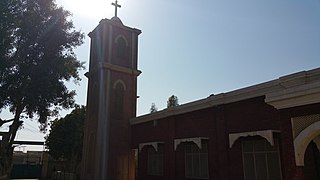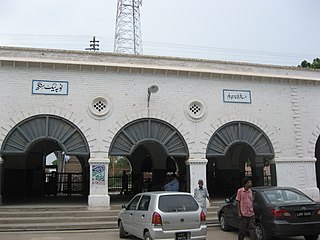Related Research Articles

Faisalabad, formerly known as Lyallpur, is the second largest city and industrial heart of Punjab, Pakistan. With an estimated population of 3.8 million in 2024, it is the second-largest Punjabi-speaking city in the world.

Toba Tek Singh District is a district of Faisalabad Division in the Punjab province of Pakistan. It is located between 30°33' to 31°2' Degree north latitudes and 72°08' to 72°48' Degree longitudes. It became a separate district in 1982.

Toba Tek Singh is a Pakistan city and capital of Toba Tek Singh District in the Punjab province. It is surrounded by cities of Gojra, Kamalia, Rajana, Pir Mahal and Shorkot.
Sandal Bar, also known as Jangal Bar, is a sub-region of the Bar region in Punjab, Pakistan, located between the Chenab and Ravi rivers, covering parts of the Rechna Doab.
Montgomery District was an administrative district of the former Punjab Province of British India, in what is now Pakistan. Named after Sir Robert Montgomery, it lay in the Bari Doab, or the tract between the Sutlej and the Ravi rivers, extending also across the Ravi into the Rechna Doab, which lies between the Ravi and the Chenab. The administrative headquarters was the town of Montgomery, present-day Sahiwal. In 1967, the name of Montgomery District was changed to Sahiwal District.

Rachna Doab can be classified as one of the main regions of Punjab, Pakistan. Punjab historically has been divided into regions based on its various rivers, since the name Punjab is based on its five main rivers. Rachna doab includes all the area between the Chenab and Ravi Rivers, all the way from the Jammu Division till their confluence in Punjab, Pakistan. It lies between 30° 35' and 32° 50' N. and 71° 50' and 75° 3' E. The name was given by the Mughal emperor Akbar, by combining the first syllables of the names of the two rivers.

Kamalia is a city in the Toba Tek Singh District of Punjab, Pakistan. It is the administrative center of Kamalia Tehsil. It is the 42nd most populous city of Pakistan and has a considerable more population compared to the nearby cities of Rajana, Chichawatni and Pir Mahal.
Khanki Headworks is a headworks situated on the River Chenab in Gujranwala District of the Punjab province of Pakistan. The construction of this headworks was completed in 1889 and was one of the oldest headworks in Pakistan.

Rajana is a town of district Toba Tek Singh, Punjab, Pakistan. It is 15 km away from Toba Tek Singh. It is located west of Faisalabad, east of Multan, south of Toba Tek Singh and north of Kamalia and Vehari.
Toba Tek Singh is a subdivision (tehsil) of Toba Tek Singh District in the Punjab province of Pakistan. It is administratively subdivided into 32 Union Councils, three of which form the tehsil capital Toba Tek Singh.
Shorkot is a tehsil in Jhang District, Punjab, Pakistan. It is subdivided into 29 Union Councils. The city of Shorkot is the headquarters of the tehsil.
The Kathia is a Muslim tribe of Pakistani Punjab.They are a branch of Panwar Rajputs. Many leaders of Kathia tribe were main participants in the Indian Rebellion of 1857 led by Rai Ahmad Khan Kharal.
Alowal is a village in Toba Tek Singh District in the Punjab, Pakistan. It is 16 km in North West of Toba Tek Singh, accessible by a good metalled road. It is sandwiched between Jhang Toba road and Akalwala road. The M-4 Motorway is 6 km from Alowal.
Divisional Public Schools and Colleges, established in 1963, is a series of mega-schools at the division level in Punjab, Pakistan. The series consists of one of the largest institutions providing education at school level in Pakistan. They are selective schools. The scheme of Divisional Public Schools was initiated in 1958–59, when the “Sharif Commission”, a special commission on national education for secondary education submitted detailed recommendations on primary through post-graduate education.
Pirmahal is a tehsil in Toba Tek Singh District, Punjab, Pakistan. The capital is Pir Mahal. Government of Punjab, Pakistan issue notification of Pir Mahal Tehsil on 24 January 2013, with effect from 1 February 2013. before this Pir Mahal was a sub-tehsil of Kamalia Tehsil of Punjab, Pakistan. Pir Mahal Tehsil consist four small towns and according to the notification of Government of Punjab, Pakistan, Pirmahal Tehsil has 16 Union councils consisting of 133 Revenue Estates.

Arbab Town is a town of Rajana, Punjab, Pakistan. It is 15 km away from Toba Tek Singh. It is located west of Faisalabad, east of Multan, south of Toba Tek Singh and north of Kamalia and Vehari. Arbab Town is a new territory. Many people from the villages nearby go there to buy Plats to develop their houses. The closest villages are Chak No. 285 GB, & New Interchange will be built beside the Arbab Town Rajana of Karachi Lahore Motorway.
Kamalia is a city in Toba Tek Singh District, Punjab, Pakistan.
Farkhanda Amjad Ali Warraich was a Pakistani politician who had been a member of the National Assembly of Pakistan from 2008 to 2013.
Changaiz Ahmed Khan Kakar, is a Pakistani politician and lawyer who is a member of the National Assembly of Pakistan from Constituency NA-102 Faisalabad-VIII, in office since 29 February 2024. Previously, he served as a Member Punjab Bar Council.
References
- ↑ "Population Characteristics" (PDF).
- ↑ Saeed, Tariq (7 August 2022). "Boat bridge dismantled after rise in water level". dawn.com. Retrieved 7 November 2024.
- ↑ Saeed, Tariq (7 August 2022). "Boat bridge dismantled after rise in water level". dawn.com. Retrieved 7 November 2024.
- ↑ Oviedo de Valeria, Jenny (2 August 1994). "chrome-extension://efaidnbmnnnibpcajpcglclefindmkaj/http://www.revista-educacion-matematica.org.mx/descargas/vol6/vol6-2/vol6-2-5.pdf". Educación matemática. 6 (2): 73–86. doi:10.24844/em0602.06. ISSN 2448-8089.
- ↑ "Punjab | History, Culture & Economy". www.britannica.com. 6 November 2024. Retrieved 7 November 2024.
- ↑ Dr.Turab sargana (21 May 2020). Punjab and the War of Independence and kathia tribe . Retrieved 7 November 2024– via YouTube.
- ↑ UrduPoint.com (1 June 2023). South Punjab Ke Ustad Noor Samad Kathia Jis Ne Expensive Horses Paal Rakhe Or Unhe Dance Sikhate Ha . Retrieved 7 November 2024– via YouTube.
- ↑ JG98 (12 May 2024). "I want to highlight Rai Ahmad Khan Kharal, a lesser known but significant Panjabi freedom fighter from the 1857 rebellions". r/punjab. Retrieved 7 November 2024.
{{cite web}}: CS1 maint: numeric names: authors list (link) - ↑ "More villages ravaged by Ravi, Chenab". dawn.com. 10 September 2014. Retrieved 7 November 2024.
- ↑ "Bhussi Kathian · Toba Tek Singh District, Punjab, Pakistan". Bhussi Kathian · Toba Tek Singh District, Punjab, Pakistan. Retrieved 6 November 2024.
- ↑ "Driving directions and traffic reports by Waze". www.waze.com. Retrieved 7 November 2024.
- ↑ Saeed, Tariq (7 August 2022). "Boat bridge dismantled after rise in water level". dawn.com. Retrieved 7 November 2024.
- ↑ Saeed, Tariq (7 August 2022). "Boat bridge dismantled after rise in water level". dawn.com. Retrieved 7 November 2024.
- ↑ "About Faisalabad - Faisalabad Development Authority". fda.gov.pk. Retrieved 7 November 2024.
- ↑ "Jhang Sadar | Geography, City, & Area". www.britannica.com. Retrieved 7 November 2024.
- ↑ "School information".
- ↑ "Bhussi Police station". YouTube . 22 January 2024.
- ↑ "Punjab Bar courts".
- ↑ "Punjab Bar Council".
- ↑ "SDPO Toba Tek singh".
- ↑ "Bhusi police station". YouTube . 7 December 2023.
- ↑ "No Pakistani prime minister has completed a full term in office". Al Jazeera. Retrieved 7 November 2024.
- ↑ Saeed, Tariq (7 August 2022). "Boat bridge dismantled after rise in water level". dawn.com. Retrieved 7 November 2024.
- ↑ "WAPDA" (PDF).
- ↑ "Nowruz | Festival, History, Practice, & Facts | Britannica". www.britannica.com. 22 September 2024. Retrieved 7 November 2024.